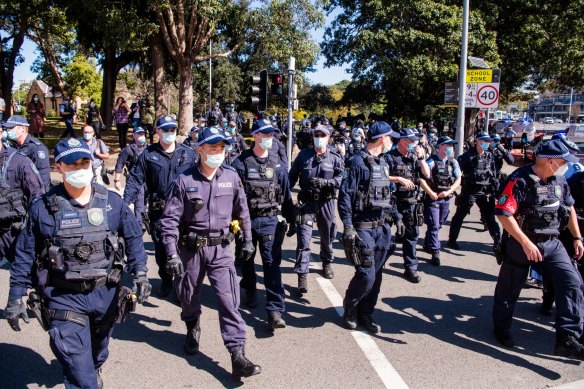This was published 11 months ago
Police suffering mental health injuries drive compensation spike
Police officers suffering from psychological injuries are driving a big spike in compensation payments to NSW frontline workers, with claim numbers soaring 64 per cent over five years on the back of the COVID pandemic
Taxpayer-funded workers’ compensation payments topped $1 billion in 2022-23, according to the latest auditor-general report into the embattled state insurer icare. In 2018-19, the bill was $648 million.

Police attending an anti-lockdown protest at Victoria Park in Sydney.Credit: James Brickwood
A rise in psychological injuries was behind the rising number of compensation claims, as police were increasingly discharged from the force on medical grounds after being assessed as unable to return to work, the report says.
The stress of frontline work during the pandemic is recognised by the government as a major driver for the spike in psychological injuries, against a backdrop of a shortage of 1500 police officers, with a further 432 on restricted duties.
There has also been a rise in psychological injuries among other frontline workers, including teachers and nurses, which the government puts down to an increase in burnout and stress, greater awareness of workplace psychological injuries, and less stigma around reporting mental health concerns.
The changing nature of work is also seen as a major contributor to psychological injuries.
The audit report warns that over the past five years, return-to-work rates have fallen and the cost of the Treasury Managed Fund, which provides workers compensation to public sector workers, has increased significantly.
Fifty-four per cent of workers with psychological injuries returned to work within 13 weeks in 2018-19. However, that has now fallen to 40 per cent, according to the audit report.
It says that psychological injury claims often involve longer periods away from work and higher costs to the scheme compared to other types of workers’ compensation claims.
As the largest public sector insurer in Australia, icare covers more than 3 million employees for wages and medical costs for workplace injuries. It collects more than $3 billion annually in premiums.
The insurer was at the centre of one of the biggest underpayment scandals involving a government agency after a joint investigation by the Herald and ABC TV’s Four Corners uncovered mismanagement, deteriorating return-to-work rates and the underpayment of thousands of injured workers.
The audit report said that although icare was implementing major reforms, its “activities have not focused enough on its core responsibilities of improving return to work and maintaining financial sustainability”.
A spokesperson for Work Health and Safety Minister Sophie Cotsis said the audit report confirmed “what we have been hearing for some time and reaffirms the approach the government has taken to improving accountability, performance, and outcomes”.
“Last year, the government passed laws that improved transparency at icare and provided Treasury with oversight powers,” the spokesperson said.
The government is also working on a whole-of-government return-to-work strategy.
“Under the current system we inherited, a worker injured in a hospital or school is often not allowed to return to work at another hospital or school – even when there is a vacancy, and they have the suitable capability,” the spokesperson said. “The new strategy will ensure that people who are injured at work can return to suitable duties where it is safe.”
The spokesperson said the government had instructed Treasury to conduct an operational spending review to reduce icare’s internal costs.
“The Audit Office reaffirms the approach the government is taking, and we will ensure the recommendations are progressed by departments and icare,” they said.
In June last year, icare needed an eleventh-hour state government top-up of more than $660 million, so it could continue to pay injured frontline public servants.
At the time, Treasurer Daniel Mookhey said an increase in workers’ compensation claims contributed to the need for the top-up, as well as a rise in medical malpractice and historical child sex abuse liabilities, and property damage from last year’s northern rivers floods.
Start the day with a summary of the day’s most important and interesting stories, analysis and insights. Sign up for our Morning Edition newsletter.